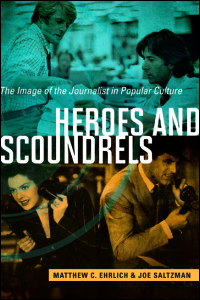
Heroes and Scoundrels:
The Image of the Journalist in Popular Culture

By Matthew C. Ehrlich
Professor of journalism at the
University of Illinois at Urbana-Champaign
and
Joe Saltzman
Professor of journalism and communication
at the University of Southern California
Publication date: April 2015. University of Illinois Press
Image
Chapter Five
In this chapter we look more closely at the drama and conflicts that have surrounded photojournalists and television journalists in popular culture. They sometimes are portrayed as doing exactly what journalists say they should do: they promote accuracy and fairness, document wrongdoing and evil, and push citizens toward empathy and justice. Other times they represent the worst fears about visual media: an oppressive force that lends itself to fabrication, trivialization, and dehumanization.
Ehrlich-Saltzman, Heroes and Scoundrels: The Image of the Journalist in Popular Culture – page 102. ©University of Illinois Press, 2015
The enduring stereotypes of photojournalists and television journalists highlight the uneasy place of the visual image in our culture. According to Kiku Adatto, as far back as the nineteenth century critics were arguing that “pictures threatened to overwhelm words, to crowd out serious reflection with titillation, sensation, and distraction.” Now, in the twenty-first century, “the line between news and entertainment, serious news and tabloid news has eroded,” and “the producers of the news are embracing theater rather than apologizing for it” by putting “pretty faces, and, in the case of women, pretty bodies on display.” From such a perspective it is small wonder that popular culture presents grimy male news photographers and shallow female broadcasters, not to mention packs of nameless journalists who shove cameras and microphones into the face of anyone who seems to present a potential story. Small wonder, too, that quality journalism has appeared more likely to be the province of the print media—after all, Lou Grant had to escape Ted Baxter and join a newspaper (and an hour-long drama series as opposed to a half-hour comedy) in order to produce serious news coverage on a consistent basis.
Ehrlich-Saltzman, Heroes and Scoundrels: The Image of the Journalist in Popular Culture – page 116. ©University of Illinois Press, 2015
According to popular culture, the visual media, with their appeal to the emotions, can rouse the rabble to catastrophic ends, but in the right hands they can move us as a people toward greatness.
Ehrlich-Saltzman, Heroes and Scoundrels: The Image of the Journalist in Popular Culture – page 120. ©University of Illinois Press, 2015
This chapter includes: Early Photojournalists, Robert Capa-Inspired Photojournalists, Female Photojournalists and Paparazzi, Television Journalists: Development of a Stereotype.
Other Resources:
New Film: Nightcrawler
Ashley Ragovin, N is for News: The Image of the Journalist on Sesame Street,” IJPC Journal 2 (2010): 58, http://ijpc.uscannenberg.org/journal/index.php/ijpcjournal/article/view/19/27
From Headline Shooter to Picture Snatcher:http://ijpc.org/uploads/files/bonnie%20brennen%20article.pdf
Richard Ness, From a Voice in the Night to a Face in the Crowd, the Rise and Fall of the Radio Film.
Law & Disorder: The Image of the Journalist in the Television's Law & Order Series, by Caley K. Cook, a thesis presented to the faculty of the Graduate School at the University of Southern California in partial fulfillment of the requirements for the degree of Master of Arts (Print Journalism), 2007.
Check out the other chapters: